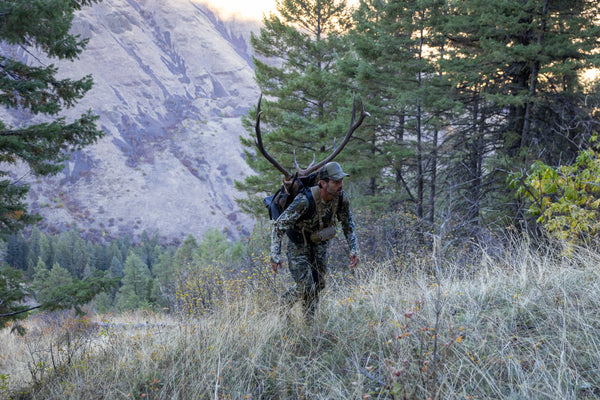Top Hunting Base Layers for Cold Weather: Keep the Chill Out
Dec 13, 2024
Nothing can derail your focus faster than the creeping chill of low temperatures when you're out in the field during a cold-weather hunt. Staying warm and dry isn’t just about comfort—it’s about maintaining your edge and endurance throughout the hunt. This is where having the right hunting base layer comes into play. A well-chosen hunting base layer will wick away moisture, regulate your body temperature, and keep you insulated from the cold, making all the difference between a successful hunt and a miserable experience.
In this guide, we’ll cover everything you need to know about choosing the best hunting base layers for cold weather, including top recommendations and layering strategies to keep you warm and ready in any condition.
Ready to Stay Comfortable in Any Weather?
SKRE Gear® has the top merino wool base layers for hiking, skiing, and everyday wear to find the perfect layer for warmth, breathability, and all-day comfort. Check out our recommendations and elevate your outdoor gear today!
Read our Base Layers for Any Activity Blog
Why Hunting Base Layers Matter in Cold Weather Hunting
The Role of Hunting Base Layers
Hunting base layers are the foundation of your clothing system. They serve three primary functions:
-
Moisture Management: Wicking sweat away from your skin to keep you
dry.

- Insulation: Trapping heat to keep you warm in cold conditions.
- Comfort: Providing a soft, friction-free layer against your skin, allowing for maximum mobility.
The Science of Layering
A proper layering system consists of three key layers:
- Base Layer: Wicks moisture and regulates temperature.
- Mid Layer: Provides additional insulation (e.g., fleece or down).
- Outer Layer: Protects against wind, rain, and snow (e.g., waterproof shells).
The hunting base layer is the most important part of this system because it directly affects how dry and warm you stay.
Consequences of Poor Hunting Base Layer Choices
Wearing the wrong hunting base layer can lead to:
- Sweat Buildup: Wet clothing against your skin can cause you to chill rapidly.
- Chafing: Poorly fitting or rough fabrics can irritate.
- Heat Loss: Insufficient insulation can lead to discomfort or even hypothermia.
Key Features to Look for in Cold Weather Hunting Base Layers
Material Types
The material of your hunting base layer plays a huge role in its performance. The two most popular materials are:
- Merino Wool
- Pros: Excellent insulation, moisture-wicking, odor resistance, and comfort.
- Cons: Higher cost and slightly less durable than synthetics.
- Synthetic Blends
- Pros: Quick-drying, durable, and often more affordable.
- Cons: Less effective at odor control compared to merino wool.

Weight Categories
Hunting base layers come in different weights to match various levels of cold:
- Lightweight: Best for early-season cold or layering under multiple garments.
- Midweight: Versatile for moderate cold and active hunts.
- Heavyweight: Ideal for extreme cold and stationary hunts.
Fit and Comfort
A snug (but not tight) fit is essential. Your hunting base layer should sit close to your skin to effectively wick moisture and trap heat without restricting movement.
Odor Control and Breathability
- Merino Wool: Naturally resists odor.
- Synthetic Blends: Many are treated with antimicrobial properties to help reduce odor buildup.
Breathability is key to preventing sweat accumulation and staying dry.
Top Merino Wool Hunting Base Layers for Cold Weather
Why Choose Merino Wool?
Merino wool excels in cold-weather conditions thanks to its natural insulation and moisture-wicking properties. It’s soft, breathable, and resists odor even after multiple days in the field.
Product Recommendations
- SKRE Gear Kaibab 300 Merino Wool Hunting Base Layer
- Features: Midweight merino wool that provides excellent warmth and breathability.
- Best For: Cold mornings and all-day hunts in variable weather.
- SKRE Gear Wasatch Crew Top Hunting Base Layer
- Features: Heavyweight merino wool for extreme cold, designed to trap heat without bulk.
- Best For: Late-season hunts and stationary hunting situations.
Ready to Stay Comfortable in Any Weather?
SKRE Gear® has the top merino wool base layers for hiking, skiing, and everyday wear to find the perfect layer for warmth, breathability, and all-day comfort. Check out our recommendations and elevate your outdoor gear today!
Read our Base Layers for Any Activity Blog
How to Layer Hunting Base Layers for Maximum Warmth
Early-Season Cold
- Recommendation: Lightweight merino wool or synthetic hunting base layer.
- Pair With: A breathable mid-layer for added warmth during chilly mornings.
Mid-to-Late Season Cold
-
Recommendation: Midweight merino wool or synthetic blend hunting base
layer.

- Pair With: An insulated mid-layer and a waterproof outer shell for protection against wind and moisture.
Extreme Cold
- Recommendation: Heavyweight merino wool hunting base layer.
- Pair With: A thick mid-layer (like fleece or down) and a windproof, insulated outer layer to stay warm in sub-zero conditions.
Tips for Maintaining and Caring for Your Hunting Base Layers
Washing and Drying Merino Wool
- Use a gentle cycle with cold water.
- Avoid fabric softeners.
- Air dry to prevent shrinkage.
Caring for Synthetic Layers
- Wash in warm water.
- Avoid high heat when drying to preserve elasticity.
- Skip the fabric softener to maintain moisture-wicking properties.
Storage Tips
- Store hunting base layers in a dry, cool place.
- Avoid storing in plastic bags to prevent moisture buildup.
Conclusion
Choosing the right hunting base layer is essential for staying warm, dry, and focused during cold-weather hunts. Whether you prefer the natural warmth of merino wool or the quick-drying durability of synthetic blends, having the right gear will keep the chill out and your performance high.
Explore our recommended hunting base layers and make sure you’re ready for your next cold-weather hunt. Visit skregear.com today to get your late season hunting base layers today.



